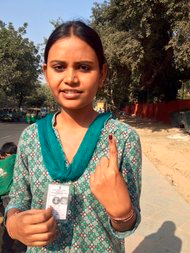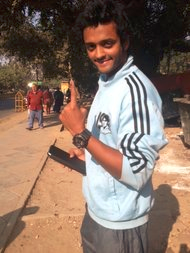A Three-Way Race Draws Delhi’s Young, and Everyone Else, Out to Vote
The article by Betwa Sharma was published in the New York Times on December 4, 2013. Sunil Abraham is quoted.
Finally, the Election Commission said it would wait until 9:30 p.m. to close the polls. At the polling station in the New Delhi district, those waiting in line agreed that a relatively warm winter evening was helping to draw people out to vote.
Though no official data on voter turnout had been released by 9 p.m., it was clear that voters were coming out in unprecedented numbers for this year’s Delhi state elections. Analysts were predicting that this election would break the previous voter turnout record of 61.75 percent in 1993.
Unlike in the past, this year’s contest featured a potential spoiler in the Aam Aadmi, or Common Man, Party. Its leader, the firebrand anticorruption activist Arvind Kejriwal, was battling to dethrone the state’s longtime chief minister, Sheila Dikshit of the Congress Party, and siphon votes from the other establishment choice, the Bharatiya Janata Party, or B.J.P. (Exit polls by the local media on Wednesday night were showing that the B.J.P. was likely to win the most seats in the state assembly.)
The prospect of upending the political status quo brought out young voters like 23-year-old Hina Kousar, although she had to put up a fight with her family to cast her vote for the Aam Aadmi Party. Her mother lectured her on how governments don’t care about people, but that didn’t deter Ms. Kousar.
“They have the wrong mentality, and young people should change it,” she said. “My granny is 70 years old and I told her to vote.”
Many of the youthful voters turned voting into a social activity, both in person and online. At one polling station, most people cast their votes quietly and left, but many of the young voters came with their friends. They talked animatedly about their choices while leaving the polling stations.
Others called their families to say they had voted. Some clicked photos of each other on their smartphones and posted the images on their Facebook pages.
In less than a year, Mr. Kejriwal, 45, and his party has pasted itself quite literally on city’s consciousness with aggressive campaigns and posters of brooms, symbolizing sweeping away the old order. And that’s why he got Ms. Kousar’s vote.
“The most important thing is that he has promised to remove corruption. The money that is going into Swiss banks is our money. The rising market prices are because of it,” she said.
Several voters between the ages of 20 to 25 who were interviewed by India Ink said they were backing Mr. Kejriwal, who represented a change from the three-term winner Ms. Dikshit. The B.J.P. had no star state candidate that appealed to them, even though its prime ministerial candidate, Narendra Modi, engaged with students at Delhi University earlier this year and is extremely active on social media.
Besides corruption, several young voters, both male and female, said that ensuring women’s safety had to be a priority for any Delhi government.
|
Another Kejriwal voter, Kavita, a 27-year-old teacher who goes by one name, said that Ms. Dikshit’s government hadn’t effectively improved women’s safety after the gang rape of a physiotherapy student one year ago. “I don’t feel the difference,” she said. “I still feel unsafe on the streets, so let’s see what some new leaders can do to change this.” Abhilash Sasidharan, 26, after he cast his vote at a polling booth in New Delhi on Wednesday.Betwa Sharma Abhilash Sasidharan, 26, after he cast his vote at a polling booth in New Delhi on Wednesday. Another Kejriwal supporter, Abhilash Sasidharan, 27, said a safe environment for women is “absolutely” the most important thing to him, but the software engineer also was moved that Mr. Kejriwal had left his lucrative job as a revenue service officer to join politics. |
Kavita, 27, after she cast her vote at a polling booth in New Delhi on Wednesday. |
|
“I don’t have the courage to step into dirty politics, but he does and I want to support that,” he said. “Look, Congress has had 15 years, so why not see if someone can do better, and all these parties should feel a threat to do better.” But not all young people are buying Mr. Kejriwal’s promises of sweeping change. Shiv Raj Syal, 20, called them “flowery and too good to believe,” as he cast his vote for Ms. Dikshit. “He is just very new at this and I don’t think it’s wise to hand over the running of a national capital to a party with no experience,” he said. The chief minister had focused on development, the college student said, making Delhi a hub for foreign brands and corporates, and transforming it into an international city. |
Abhilash Sasidharan, 26, after he cast his vote at a polling booth in New Delhi on Wednesday. |
Despite the appearance of a robust youth presence at the polls on Wednesday, analysts are waiting on the Election Commission’s numbers before declaring this election cycle the year of the youth vote.
Sanjay Kumar, an election analyst from the Center for the Study of Developing Societies in Delhi, said that as of July, only 68 percent of eligible voters between the ages of 18 and 21 had registered to vote, far lower than the 86 percent average of other demographics.
V.S. Sampath, the chief election commissioner in India, said that youth participation in the electoral process had been a priority in recent years, and several efforts including visiting universities and colleges had been made to register them, which had resulted in a “significant increase.”
In 2011, Mr. Sampath said, 119,000 voters between the ages of 18 and 19 were on the electoral rolls in Delhi, which accounted for 0.93 percent of total Delhi voters, but now the numbers had gone up to 405,000, or 3.4 percent.
Election observers have also pointed out that the hype about social media, especially Twitter, becoming a tool for political expression and organization for the youth has not necessarily translated into a surge in voting in that demographic of users.
The political debates on social media could translate into votes by the next elections, according to Sunil Abraham from the Centere of Internet and Society in Bangalore, who describes the Internet penetration as “limited,” and social media use even smaller and dominated by the economic elite.
Mr. Abraham, however, said social media is influencing the political discourse, not by motivating voters, but by influencing the coverage in mainstream media.
Relative to the country’s population, he added, social media users had a “disproportionate influence on discourse.”
But the young voters who spoke to India Ink said that at least for them, social media did play a role in drawing them into politics this year. Mr. Syal, the Congress voter, for instance, said that he had posted a message on his Facebook wall criticizing some of Mr. Kejriwal’s claims, which drew 50 comments.
And Mr. Sasidharan, the Aam Aadmi Party supporter, posted on Facebook a photo of him holding up his finger stained with ink, showing that he voted, immediately after coming out of the polling station. “I hope that it inspires more people to come and vote,” he said.






